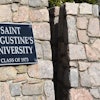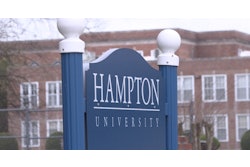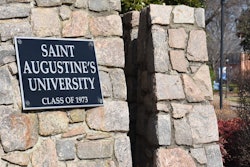RICHMOND, Va.
When Ariel Brown was offered a chance to transcribe the correspondence of the first family of the Confederacy, the history major with a keen interest in the South seized the opportunity.
Then the student from historically Black North Carolina Central University in Durham let her colleagues know she would be doing her research at The Museum of the Confederacy.
“It was a stare of, ‘Oh, wow, what is she doing there?’”
Brown, 25, said she understands the reaction from fellow African-Americans who are offended by the Confederacy.
Undaunted, Brown was one of three N.C. Central graduate students who sorted through 42 boxes of documents related to the family of Jefferson Davis, the Confederacy’s lone president. In a museum that began as a memorial to the Confederate cause, this was scholarship tinged with irony.
The paid interns worked in a second-floor room overlooking the back portico and garden of the former Confederate White House, where Davis led the secessionist slave states during the Civil War.
Museum president and CEO S. Waite Rawls III acknowledged there is a “gee whiz”’ element to students from an historically Black university working amid the nation’s most extensive collection of Confederate artifacts.
“Normal thought would be, a Black university in a Confederate museum? That doesn’t make sense,” Rawls said of the collaboration. “It’s a great statement, I think, to people who look at everything through a political lens.”
Their work, he added, is consistent with the museum’s growing mission to reflect the social history of the Civil War, including the roles of women and African-Americans, not just the generals, battles and weapons.
The door has not always been open to Black historians’ working on the Confederacy and the South. The late Dr. John Hope Franklin wrote of the bigotry he encountered – in the South and elsewhere – during his distinguished career chronicling African-American history.
Dr. Ervin L. Jordan Jr., an associate professor at the University of Virginia who has written extensively on the Civil War, recalls being turned away in 1986 by a so-called Southern heritage group in Richmond when he sought to examine its records for a book he was researching.
“There have been African-Americans, myself included, who find aspects of the Confederacy to be of interest,”’ Jordan said. “But the response of some Whites … is something that has caused me problems in terms of doing research.”
On the flip side, he said, “African-Americans view the Confederacy as the evil empire.”
Still, Jordan credits the Museum of the Confederacy for seeking connections with African-Americans and an historically Black institution such as N.C. Central.
Rawls and other museum officials are enthused with the work of the interns, and the students in turn are grateful for the opportunity.
Brown, Eric J. Richardson and Clyde Wilson Sr. have painstakingly catalogued and transcribed the handwritten correspondence and other papers related to Varina Davis, Jefferson’s second wife, and their six children. The Davis family’s story adds nuance and some humanity to the patriarch, who has been called the “Sphinx of the Confederacy” because of his private nature.
The work of the interns will make the collections more easily accessible to historians.
“It’s really essential to our work,” said Lynda Crist, editor and project director of “The Papers of Jefferson Davis” at Rice University. “We’re trying to put Davis’s literary remains, as someone called them, back together in chronological order. Any personal material is immensely valuable.”
Museum library manager Teresa E. Roane, who has overseen the work of the three, said the transcriptions run from the mundane to the poignant: from government-related materials to personal letters, such as Varina’s tender correspondence with her husband after he was jailed at Fort Monroe in Hampton for treason.
“These letters are both extremely revealing and intimate because they both worried they might never see each other again, that he might be executed or exiled,” Crist said.
Wilson was especially taken by Benjamin Montgomery, an enslaved man who was Davis’s personal secretary. He was given extraordinary responsibilities involving the family’s private holdings. Wilson was dazzled by Montgomery’s management skills and his correspondence with Davis, who obviously had great confidence in this man.
“Benjamin Montgomery stands out as a star amidst a dark situation,” Wilson, 54, said. “Here is the possibility of what can occur.”
Having grown up in the segregated South, Wilson said he found these stories not only inspirational but personal.
“I don’t want to disconnect from who I am,” he said. “Let’s not be afraid of this Confederate narrative because we too are a part of this narrative.”
Varina Davis offered a rich vein of material for all three researchers. She was a supportive, loyal partner who did not quite fit into proper Richmond society. After her husband’s death in 1889, she left the South for a New York literary career.
“The women here called her a squaw,” Richardson, 45, said of Varina’s reception in Richmond. “They talked about how dark her skin was, that she was not of a class that should have married Jefferson Davis.”
“What it was was jealousy. This woman could hold her own,” said Richardson, who proposed the internships to N.C. Central and the museum.
There is some historical evidence Varina Davis was of Native American heritage, he said.
The students also encountered the offbeat, including a letter dated Dec. 3, 1863, from Pope Pius IX. In a translation from the Latin, the pontiff expresses “the spirit of Christian charity and peace upon all those people of America and deliver them from the evils so great with which they are afflicted.”
“That is the beauty of it all, finding these interesting materials,” Roane said.
Rawls is hopeful he can build on the N.C. Central relationship with some of the nation’s more than 100 historically Black colleges and universities.
© Copyright 2005 by DiverseEducation.com















